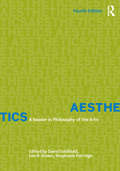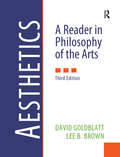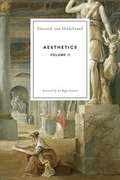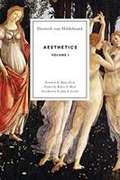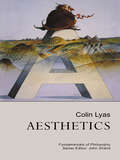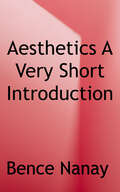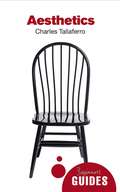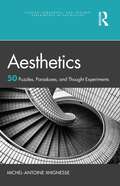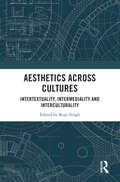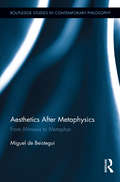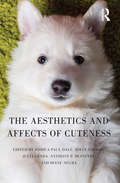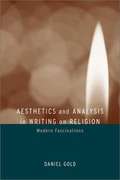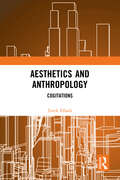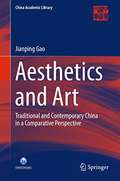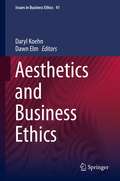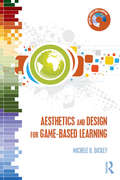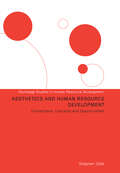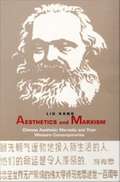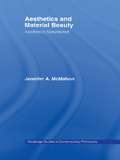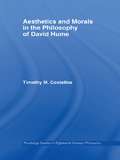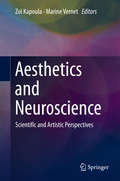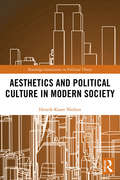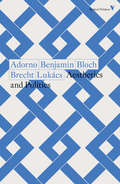- Table View
- List View
Aesthetics
by Michael GandyThe attempt to put a big box store in the middle of an upscale development turns the town of Millicent, Mississippi, on its head, with opponents on both sides of the issue turning deadly.
Aesthetics: A Reader in Philosophy of the Arts
by David Goldblatt Lee B. Brown Stephanie PatridgeAesthetics: A Reader in Philosophy of the Arts, fourth edition, contains a selection of ninety-six readings organized by individual art forms as well as a final section of readings in philosophical aesthetics that cover multiple art forms. Sections include topics that are familiar to students such as painting, photography and movies, architecture, music, literature, and performance, as well as contemporary subjects such as mass art, popular arts, the aesthetics of the everyday, and the natural environment. Essays are drawn from both the analytic and continental traditions, and multiple others that bridge this divide between these traditions. Throughout, readings are brief, accessible for undergraduates, and conceptually focused, allowing instructors many different syllabi possibilities using only this single volume. Key Additions to the Fourth Edition The fourth edition is expanded to include a total of ninety-six essays with nineteen new essays (nine of them written exclusively for this volume), updated organization into new sections, revised introductions to each section, an increased emphasis on contemporary topics, such as stand-up comedy, the architecture of museums, interactivity and video games, the ethics of sexiness, trans/gendered beauty, the aesthetics of junkyards and street art, pornography, and the inclusion of more diverse philosophical voices. Nevertheless, this edition does not neglect classic writers in the traditional aesthetics: Plato, Aristotle, Hume, Kant, Hegel, Heidegger, Collingwood, Bell, and writers of similar status in aesthetics. The philosophers writing new chapters exclusively for this fourth edition are: • Sondra Bacharach on street art • Aili Bresnahan on appreciating dance • Hina Jamelle on digital architecture • Jason Leddington on magic • Sheila Lintott on stand-up comedy • Yuriko Saito on everyday aesthetics • Larry Shiner on art spectacle museums in the twenty-first century • Peg Brand Weiser on how beauty matters • Edward Winters on the feeling of being at home in vernacular architecture, as in such urban places as bars.
Aesthetics: A Reader in Philosophy of the Arts
by David Goldblatt Lee B. BrownAs with previous editions, the new Aesthetics: A Reader in Philosophy of the Arts uses classic and contemporary readings of leading philosophers of the arts. This Third Edition includes more than a dozen new essays either written or adapted especially for this volume. Containing more than 90 essays in total, the new edition offers generous choices for class readings, thus minimizing supplementary material needed for required assignments and independent research. In keeping with earlier editions, the Third Edition is a large collection of essays, most comparatively brief and organized first by groupings of art forms and then by general essays about the arts. It attempts to keep pace with theorizing about those art forms not traditionally covered in most books on aesthetics, like the jazz, rock, comics, video games, and even the aesthetics of junkyards. There is, then, an emphasis on the popular and mass arts and everyday aesthetics, as well as on time-honored problems in philosophy of the arts. This edition, which contains contributions by both analytic and continental philosophers, expands upon offerings in non-Western art and aesthetics. Finally, although intended to keep pace with topics and issues currently debated, instructors and students will find, in a special section, key classic texts.
Aesthetics: Volume II
by Dietrich Von HildebrandWritten in the early 1970s during the last years of his life, as if harvesting a lifetime of reflection, Dietrich von Hildebrand's Aesthetics is a uniquely encompassing work.The first volume develops an original theory of the beautiful, and the second applies that theory with tremendous breadth and attention to the various types of artwork and to many of the world's most beloved works of art. <P><P> It is a testament to the work's broad significance that two of the most respected voices in contemporary aesthetics have joined together to offer forewords to each volume: Dana Gioia to Volume I, and Sir Roger Scruton to Volume II. <P><P> Sir Roger Scruton writes on Volume II: "In this second volume of his treatise on the subject Hildebrand assembles the results of a lifetime's thought about the arts, and expresses his devotion to beauty in terms that the reader will find immediately engaging." <P><P> He continues: "Most philosophers of aesthetics content themselves with a few examples from the realm of art, and make no attempt to explore the distinct disciplines or to catalogue all the parts that contribute to the overall aesthetic effect. One purpose of this second volume, however, is to show the completeness of the artistic enterprise, and the way in which it penetrates human life in its entirety, so that the idea of beauty enters our practical activity at every point." <P><P> Dietrich von Hildebrand's Aesthetics occupies a place in the great philosophical aesthetic tradition of Plato, Kant, and Hegel, while incorporating the fresh and fundamental insights of phenomenology. With this publication of the first English translation, Dietrich von Hildebrand becomes a contemporary spokesman and defender of the importance of beauty and aesthetic values at a time when many think that beauty is relative and art unnecessary.
Aesthetics: Volume I
by Dietrich Von HildebrandWritten in the early 1970s during the last years of his life, as if harvesting a lifetime of reflection, Aesthetics is Dietrich von Hildebrand’s comprehensive two-volume study and defense of beauty and art. With the publication of Aesthetics, Hildebrand becomes a contemporary spokesman and defender of the importance of beauty at a time when many think that beauty is relative and art unnecessary. Aesthetics: Volume I is Dietrich von Hildebrand's comprehensive work on beauty translated by Brian McNeil.
Aesthetics
by Dr Colin Lyas Colin LyasThis book presents an up-to-date introduction to the subject that captures the excitement and passion of art itself. It opens by exploring why art is important to us and goes on to grip the reader with a discussion of all of the areas central to aesthetics: aesthetic experience, representation, expression, definition of art, evaluation, interpretation, structuralism and post-structuralism, truth and morality. It draws upon the great thinkers on art, Plato and Kant, Croce and Beardsley, including the most recent iconoclastic views of Barthes and Derrida.
Aesthetics: A Very Short Introduction (Very Short Introductions Ser.)
by Bence NanayAesthetics is a branch of philosophy that explores the nature of art, beauty, and taste. It doesn't just consider traditional artistic experiences such as artworks in a museum or an opera performance, but also everyday experiences such as autumn leaves in the park, or even just the light ofthe setting sun falling on the kitchen table. It is also about your experience when you choose the shirt you're going to wear today or when you wonder whether you should put more pepper in the soup. Aesthetics is everywhere. It is one of the most important aspects of our life.In this Very Short Introduction Bence Nanay introduces the field of aesthetics, considering both Western and non-Western aesthetic traditions, and exploring why it is sometimes misunderstood or considered to be too elitist - by artists, musicians, and even philosophers. As Nanay shows, so-called"high art" has no more claims on aesthetics than sitcoms, tattoos, or punk rock. In fact, the scope of aesthetics extends far wider than that of art, high or low, including much of what we care about in life. It is not the job of aesthetics to tell you which artworks are good and which ones are bad.It is not the job of aesthetics to tell you what experiences are worth having. If an experience is worth having for you, it thereby becomes the subject of aesthetics. This realisation is important, because thinking about aesthetics in this inclusive way opens up new ways of understanding oldquestions about the social aspect of our aesthetic engagements, and the importance of aesthetic values for our own self.
Aesthetics: A Beginner's Guide (Beginner's Guides)
by Charles TaliaferroWhat is art? Why do we find some things beautiful but not others? Is it wrong to share mp3s? These are just some of the questions explored by aesthetics, the philosophy of art. In this sweeping introduction, Charles Taliaferro skilfully guides us through notions of art and beauty around the world, tackling lively debates such as who owns art and how art and morality collide. From Plato on poetry to Ringo Starr on the drums, this is a perfect introductory text for anyone interested in the intriguing questions art can raise. Charles Taliaferro is Professor of Philosophy at St. Olaf College, Minnesota. He is the author of over twenty books on philosophy and lectures on Aesthetics and the Philosophy of Religion.
Aesthetics: 50 Puzzles, Paradoxes, and Thought Experiments (Puzzles, Paradoxes, and Thought Experiments in Philosophy)
by Michel-Antoine XhignesseAesthetics: 50 Puzzles, Paradoxes, and Thought Experiments is a teaching-focused resource, which highlights the contributions that imaginative scenarios—paradoxes, puzzles, and thought experiments alike—have made to the development of contemporary analytic aesthetics. The book is divided into sections pertaining to art-making, ontology, aesthetic judgements, appreciation and interpretation, and ethics and value, and offers an accessible summary of ten debates falling under each section. Each entry also features a detailed annotated bibliography, making it an ideal companion for courses surveying a broad collection of topics and readings in aesthetics. Key Features: Uses a problem-centered approach to aesthetics (rather than author- or theory-centered) making the text more inviting to first-time students of the subject Offers stand-alone chapters, allowing students to quickly understand an issue and giving instructors flexibility in assigning readings to match the themes of the course Provides up-to-date, annotated bibliographies at the end of each entry, amounting to an extensive review of the literature on contemporary analytic aesthetics
Aesthetics across Cultures: Intertextuality, Intermediality and Interculturality
by Rosy SinghThis book critically examines the "mutual illuminations" between literature, religion, architecture, films, performative arts, paintings, woodworks, memes and masks cutting across time and space. Architecture is a good example where the eventual success of a project depends on the harmony between physical sciences and aesthetics, design and planning, knowledge of building material, the local climate and awareness of cultural sensibilities. This volume affirms that aesthetics and arts are deeply linked through existential issues of who I am. The chapters in this volume present diverse discursive structures highlighting the in-between spaces between various art forms and mediums, such as: • Architecture, literature and memory • Kafka in SoHo; Kafka and Bernhard • Kirchner’s woodcuts; pictorial and stage representations of E.T.A. Hoffmann • Hesse’s fairy tales; translations of Pañcatantra • Nietzsche, ritual arts and face masks; martyrdom in La chanson de Roland • Goethe and Hafiz; Indian thought in Martin Buber • Rhythms of the "Third" across cultures • Dadaism and contemporary memes This book examines these sublime linkages in a comparative and interdisciplinary way. Engaging and intersectional, this volume will appeal to students and scholars of arts and aesthetics, literature, philosophy, architecture, sociology, translation studies and readers who are interested in cultural, intertextual, intermedial and comparative studies.
Aesthetics After Metaphysics: From Mimesis to Metaphor (Routledge Studies in Contemporary Philosophy)
by Miguel BeisteguiThis book focuses on a dimension of art which the philosophical tradition (from Plato to Hegel and even Adorno) has consistently overlooked, such was its commitment – explicit or implicit – to mimesis and the metaphysics of truth it presupposes. De Beistegui refers to this dimension, which unfolds outside the space that stretches between the sensible and the supersensible – the space of metaphysics itself – as the hypersensible and show how the operation of art to which it corresponds is best described as metaphorical. The movement of the book, then, is from the classical or metaphysical aesthetics of mimesis (Part One) to the aesthetics of the hypersensible and metaphor (Part Two). Against much of the history of aesthetics and the metaphysical discourse on art, he argues that the philosophical value of art doesn’t consist in its ability to bridge the space between the sensible and the supersensible, or the image and the Idea, and reveal the sensible as proto-conceptual, but to open up a different sense of the sensible. His aim, then, is to shift the place and role that philosophy attributes to art.
The Aesthetics and Affects of Cuteness
by Diane Negra Joshua Paul Dale Joyce Goggin Julia Leyda Anthony P. McIntyreCuteness is one of the most culturally pervasive aesthetics of the new millennium and its rapid social proliferation suggests that the affective responses it provokes find particular purchase in a contemporary era marked by intensive media saturation and spreading economic precarity. Rejecting superficial assessments that would deem the ever-expanding plethora of cute texts trivial, The Aesthetics and Affects of Cuteness directs serious scholarly attention from a variety of academic disciplines to this ubiquitous phenomenon. The sheer plasticity of this minor aesthetic is vividly on display in this collection which draws together analyses from around the world examining cuteness’s fundamental role in cultural expressions stemming from such diverse sources as military cultures, high-end contemporary art worlds, and animal shelters. Pushing beyond prevailing understandings that associate cuteness solely with childhood or which posit an interpolated parental bond as its primary affective attachment, the essays in this collection variously draw connections between cuteness and the social, political, economic, and technological conditions of the early twenty-first century and in doing so generate fresh understandings of the central role cuteness plays in the recalibration of contemporary subjectivities.
Aesthetics and Analysis in Writing on Religion: Modern Fascinations
by Daniel GoldThis is a book that looks at contemporary challenges to studying and writing in religion, rethinking the discipline in a way that takes seriously both the aesthetic dimensions and its need for scientific discipline. Gold pursues a new line of thought about the art of religion, arguing for something he calls interpretive writing.
Aesthetics and Anthropology: Cogitations
by Tarek ElhaikThis book focuses on the reconfiguration of aesthetic anthropology into an anthropological problem of cogitation, opening up a fascinating new dialogue between the domains of anthropology, philosophy, and art. Tarek Elhaik embarks on an inquiry composed of a series of cogitations based on fieldwork in an ecology of artistic and scientific practices: from conceptual art exhibitions to architectural environments; from photographic montages to the videotaping of spirit seances; from artistic interventions in natural history museums to ongoing dialogues between performance artists and marine scientists. The chapters examine the image-work, ethical demands, and aesthetic struggles of interlocutors including artists Mathias Goeritz, Mounir Fatmi, Silvia Gruner, Joan Jonas, and Patricia Lagarde.
Aesthetics and Art: Traditional And Contemporary China In A Comparative Perspective (China Academic Library)
by Jianping GaoPresents aesthetic thoughts in traditional and contemporary China.<P><P>Compares the similarities and differences between traditional and modern Chinese aesthetics.<P>Explores the aesthetic implications of traditional Chinese paintings.<P>This book introduces traditional and modern aesthetics and arts, comparing the similarities and differences between traditional and modern Chinese aesthetics. It also explores the aesthetic implications of traditional Chinese paintings, and discusses the development of aesthetics throughout history, as well as the changes and improvements in Chinese aesthetics in the context of globalization.
Aesthetics and Business Ethics (Issues in Business Ethics #41)
by Daryl Koehn Dawn ElmLudwig Wittgenstein famously said, "Ethics is aesthetics." It is unclear what such a claim might mean and whether it is true. This book explores contentious issues arising at the interface of ethics and aesthetics. The contributions reflect on the status of aesthetic en ethical judgments, the relation of aesthetic beauty and ethical goodness and art and character development. The book further considers the potential role art could play in ethical analysis and in the classroom and explores in what respects aesthetics and ethics might be intertwined and even mutually supportive.
Aesthetics and Design for Game-based Learning (Digital Games, Simulations, and Learning)
by Michele D. DickeyAesthetics and Design for Game-based Learning provides learning designers with insight into how the different elements that comprise game aesthetics can inform the design of game-based learning. Regardless of the cognitive complexities involved, games are essentially entertainment media, and aesthetics play a large role in how they are experienced. Yet too often the role of aesthetics in the research about game-based learning has been relegated to a surface discussion of graphics or neglected altogether. Aesthetics and Design for Game-based Learning begins by addressing the broad context of game aesthetics, then addresses specific elements with chapters focusing on: player positioning game mechanics narrative design environment design character design. Each chapter includes research and guidelines for design, and a conclusion addresses aesthetics in the research of game-based learning.
Aesthetics and Environment: Variations on a Theme
by Arnold BerleantThe essays collected in Aesthetics and Environment comprise a set of variations on art and culture guided by the theme of environment. The essays deal with the physical reality of environment such as the city, the shore, the water and the garden, but also with the virtual environment and the social one. Environmental aesthetics is a theme whose variations are as endless as the possibilities of the human performers and conditions from which it is fashioned. This enticing set of essays testifies to Berleant's special talent in moving easily between both natural and human environments and opens out the contemporary discussion beyond that of the wilderness to the cultural and social environment. Berleant argues that neither the natural nor human environment stands alone and both are best understood as distinctions that are in experience coextensive, that one can only speak of environment in relation to human experience. The theme of this book is that such experience suffuses the so-called natural world and shapes the human world. It maintains the idea that in as much as people are embedded in these worlds, relationships, including human relationships, are part of them. The melding of these two worlds leads Berleant to defend ultimately what he has termed 'social aesthetics' .
Aesthetics and Human Resource Development: Connections, Concepts and Opportunities (Routledge Studies in Human Resource Development #Vol. 13)
by Stephen GibbThe first book to look at both aesthetics and human resource development, this timely and original work investigates existing, as well as possible future, connections and relations between the two areas. Well structured and expertly written, The Aesthetic Challenges of Human Resource Development is undoubtedly a valuable reference for students of human resource management, business and management, and aesthetics.
Aesthetics and Marxism: Chinese Aesthetic Marxists and Their Western Contemporaries
by Liu KangAlthough Chinese Marxism--primarily represented by Maoism--is generally seen by Western intellectuals as monolithic, Liu Kang argues that its practices and projects are as diverse as those in Western Marxism, particularly in the area of aesthetics. In this comparative study of European and Chinese Marxist traditions, Liu reveals the extent to which Chinese Marxists incorporate ideas about aesthetics and culture in their theories and practices. In doing so, he constructs a wholly new understanding of Chinese Marxism. Far from being secondary considerations in Chinese Marxism, aesthetics and culture are in fact principal concerns. In this respect, such Marxists are similar to their Western counterparts, although Europeans have had little understanding of the Chinese experience. Liu traces the genealogy of aesthetic discourse in both modern China and the West since the era of classical German thought, showing where conceptual modifications and divergences have occurred in the two traditions. He examines the work of Mao Zedong, Lu Xun, Li Zehou, Qu Qiubai, and others in China, and from the West he discusses Kant, Schiller, Schopenhauer, and Marxist theorists including Horkheimer, Adorno, Benjamin, and Marcuse. While stressing the diversity of Marxist positions within China as well as in the West, Liu explains how ideas of culture and aesthetics have offered a constructive vision for a postrevolutionary society and have affected a wide field of issues involving the problems of modernity. Forcefully argued and theoretically sophisticated, this book will appeal to students and scholars of contemporary Marxism, cultural studies, aesthetics, and modern Chinese culture, politics, and ideology.
Aesthetics and Material Beauty: Aesthetics Naturalized (Routledge Studies in Contemporary Philosophy)
by Jennifer A. McMahonIn Aesthetics and Material Beauty, Jennifer A. McMahon develops a new aesthetic theory she terms Critical Aesthetic Realism - taking Kantian aesthetics as a starting point and drawing upon contemporary theories of mind from philosophy, psychology, and cognitive science. The creative process does not proceed by a set of rules. Yet the fact that its objects can be understood or appreciated by others suggests that the creative process is constrained by principles to which others have access. According to her update of Kantian aesthetics, beauty is grounded in indeterminate yet systematic principles of perception and cognition. However, Kant’s aesthetic theory rested on a notion of indeterminacy whose consequences for understanding the nature of art were implausible. McMahon conceptualizes "indeterminacy" in terms of contemporary philosophical, psychological, and computational theories of mind. In doing so, she develops an aesthetic theory that reconciles the apparent dichotomies which stem from the tension between the determinacy of communication and the indeterminacy of creativity. Dichotomies such as universality and subjectivity, objectivity and autonomy, cognitivism and non-cognitivism, and truth and beauty are revealed as complementary features of an aesthetic judgment.
Aesthetics and Morals in the Philosophy of David Hume (Routledge Studies in Eighteenth-Century Philosophy)
by Timothy M CostelloeThe book has two aims. First, to examine the extent and significance of the connection between Hume's aesthetics and his moral philosophy; and, second, to consider how, in light of the connection, his moral philosophy answers central questions in ethics. The first aim is realized in chapters 1-4. Chapter 1 examines Hume's essay "Of the Standard of Taste" to understand his search for a "standard" and how this affects the scope of his aesthetics. Chapter 2 establishes that he treats beauty in nature and art and moral beauty as similar in kind, and applies the conclusions about his aesthetics to his moral thought. Chapter 3 solves a puzzle to which this gives rise, namely, how individuals both accept general standards that they also contravene in the course of aesthetic and moral activity. Chapter 4 takes up the normative aspect of Hume's approach by understanding moral character through his view of moral beauty. The second aim of the book is realized in chapters 5-7 by entertaining three objections against Hume's moral philosophy. First, if morality is an immediate reaction to the beauty of vice and the deformity of virtue, why is perfect virtue not the general condition of every human individual? Second, if morality consists of sentiments that arise in the subject, how can moral judgments be objective and claim universal validity? And third, if one can talk of "general standards" governing conduct, how does one account for the diversity of moral systems and their change over time? The first is answered by showing that like good taste in aesthetics, 'right taste' in morals requires that the sentiments are educated; the second, by arguing against the view that Hume is a subjectivist and a relativist, and the third (chapter 6), by showing that his approach contains a view of progress left untouched by any personal prejudices Hume himself might harbor. The book concludes in chapter 7 by showing how Hume's view of philosophy affects the scope of any normative ethics.
Aesthetics and Neuroscience: Scientific and Artistic Perspectives
by Zoï Kapoula Marine VernetThis edited monograph provides a compelling analysis of the interplay between neuroscience and aesthetics. The book broaches a wide spectrum of topics including, but not limited to, mathematics and creator algorithms, neurosciences of artistic creativity, paintings and dynamical systems as well as computational research for architecture. The international authorship is genuinely interdisciplinary and the target audience primarily comprises readers interested in transdisciplinary research between neuroscience and the broad field of aesthetics.
Aesthetics and Political Culture in Modern Society (Routledge Innovations in Political Theory)
by Henrik Kaare NielsenDo aesthetic appeals to senses and emotions in political debate necessarily marginalise political reason and reduce citizens to consumers – thus dangerously undermining democracy? Or is sensuous-emotional engagement, on the contrary, a basic fact of the political process and a crucial precondition for revitalising democracy? Aesthetics and Political Culture in Modern Society investigates the current interrelationship between aesthetic practice and political practice in Western democracies, focusing on its impact on democratic political culture. Henrik Kaare Nielsen argues that aesthetic interventions in the political process do not by definition undermine politics’ content of reason. Instead, a differentiation must be made between a multiplicity of aesthetic forms of intervention – some of which tend to weaken the political judgement of citizens while other forms tend to stimulate competent judgement. This book will be of interest to scholars in the fields of political science, sociology, media studies, and cultural studies.
Aesthetics and Politics (Radical Thinkers)
by Walter Benjamin Theodor Adorno Georg Lukacs Bertolt Brecht Ernst BlochNo other country and no other period has produced a tradition of major aesthetic debate to compare with that which unfolded in German culture from the 1930s to the 1950s. In Aesthetics and Politics the key texts of the great Marxist controversies over literature and art during these years are assembled in a single volume. They do not form a disparate collection but a continuous, interlinked debate between thinkers who have become giants of twentieth-century intellectual history.

